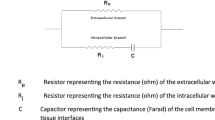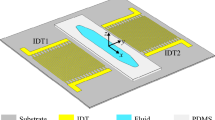Abstract
The frequency of ciliary beat was measured by laser light-scattering spectroscopy in cultures of ciliated cells of the rabbit oviduct. Measurements performed by this new method agree with those obtained by high speed cinematography. When beating cilia are illuminated by a laser beam, the scattered light shows a frequency modulation due to the oscillatory motion of cilia. The spectral structure of the scattered light depends on the frequency and time-space coherence of ciliary beat. This paper reports the experimental validation of this technique and the theoretical basis for obtaining the frequency and coherence of ciliary beat from the autocorrelation function of the spectrum of light scattered from moving cilia. Fiber optic light transmission could permit the extension of this method to assess ciliary activityin situ for applications in animal experimentation and clinical studies.
Similar content being viewed by others
References
Beckmann, P., and Spizzichino, A.The scattering of electromagnetic waves from rough surfaces. New York: Macmillan, 1963.
Bergé, P., Volochine, B., Billard, R., and Hamelin, A. Mise en évidence du mouvement propre de microorganisms vivants grâce a l'étude de la diffusion inélastique de la lumière.Comptes Rendus Hebdomadaires des Seances de l'Academie des Sciences. Series D. Sciences Naturelles 1967,256, 889–892.
Berne, B. J., and Pecora, R.Dynamic light scattering—with applications to chemistry, biology and physics. New York: Wiley, 1976.
Cummins, H. Z., and Swinney, H. L. Laser light beating spectroscopy.Progress in Optics 1970,8, 133–200.
Dalhamn, T., and Rylander, R. Frequency of ciliary beat measured with a photo-sensitive cell.Nature (London) 1962,196, 592–593.
Dubin, S. B., Lunacek, J. H., and Benedek, G. B. Observation of the spectrum of light scattered by solutions of biological macromolecules.Proceedings of National Academy of Sciences of U.S.A. 1967,57, 1164–1171.
Eckert, R., and Murakami, A. Control of ciliary activity. In R. J. Podolsky (Ed.),Contractility of muscle cells and related processes. Englewood Cliffs, N.J.: Prentice-Hall, 1971, Pp. 115–127.
Eckert, R., and Murakami, A. Calcium dependence of ciliary activity in the oviduct of the salamanderNecturus.Journal of Physiology 1972,226, 699–711.
Englemann, T. W. Über die Filmmerbewegung.Jenaische Zeitschrift für Medizia und Naturwissenschaft Leipzig 1868,4, 321–479.
Englemann, T. W. Flimmeruhr und Flimmerrmühle. Zwei Apparate zum Registriren der Flimmerbewegung.Pflüger's Archiv für die gesamte physiologie des Menschen und der Tiere 1877,15, 493–510.
Ford, N. C., Jr., and Benedek, G. B. Observation of the spectrum of light scattered from a pure fluid near its critical point.Physical Review Letters 1965,15, 649–653.
Ford, N. C., Jr. Biochemical application of laser Rayleigh scattering.Chemica Scripta 1972,2, 193–206.
Halbert, S. A., Tam, P. Y., and Blandau, R. J. Egg transport in the rabbit oviduct: The roles of cilia and muscle.Science 1976,191, 1052–1053.
Inchley, O. A simple apparatus to demonstrate activity of cilia.Journal of Physiology. Proceedings of the Physiological Society of Great Britain, London 1921,54, CXXVII-CXXVIII.
Jakeman, E., H. Z. Cummins, and R. E. Pike (Eds.), InPhoton correlation and light beating spectroscopy. New York: Plenum, 1974, Pp. 133f.
Lee, W. I., and Verdugo, P. Laser light scattering from ciliary movements.Bulletin of the American Physical Society 1976,21, 370.
Lee, W. I., and Verdugo, P. Laser light scattering spectroscopy: A new application in the study of ciliary activity.Biophysical Journal 1976,16, 1115–1119.
Lucas, A. M. An investigation of the nervous system as a possible factor in the regulation of ciliary activity of theLamellibranch gill.Journal of Morphology and Physiology 1931,51, 147–194.
Marathay, A. S., Heiko, L., and Zuckerman, J. L. Study of rough surfaces by light scattering.Applied Optics 1970,9, 2470–2476.
Martius, F. Eine Methode zur absoluten Frequenzbestimmung der Flimmerbewegung auf stroboskopischem Wege.Archiv für Anatomie und Physiologie, Leipzig 1884,8, 456–460.
Mercke, U., Håkansson, C. H., and Tovemalm, N. G. A method for standardized studies of mucociliary activity.Acta Oto-Laryngologica 1974,78, 118–123.
Naitoh, Y., and Kaneko, H. Control of ciliary activities by adenosine-triphosphate and divalent cations in tritonextracted models ofParamecium caudatum.Journal of Experimental Biology 1973,58, 657–676.
Nossal, R., and Chen, S. H. Light scattering from motile bacteria.Journal de Physique Colloque C-1, 1972,33, 171–176.
Proetz, A. W. An apparatus for observing ciliary motion. InTransactions of the section on laryngology, otology, & rhinology of the American Medical Association, 1933. Pp. 260–262.
Pecora, R. Doppler shifts in light scattering from pure liquids and polymer solutions.Journal of Chemical Physics 1964,40, 1604–1614.
Rumery, R. E., Phinney, E., and Blandau, R. J. Culture of mammalian embryonic ovaries and oviducts. In J. C. Daniel, Jr. (Ed.),Methods in mammalian embryology. San Francisco: W.H. Freeman, 1971. Pp. 472–495.
Sharpey, W. Cilia. In Todd'sCyclopaedia of anatomy and physiology. London: Longman, Brown, Green, Roberts, 1935, Vol. 1, pp. 606–636.
Tanaka, T., and Benedek, G. B. Measurement of the velocity of blood (in vivo) using a fiber optic catheter and optical mixing spectroscopy.Applied Optics 1975,14, 189–196.
Author information
Authors and Affiliations
Additional information
Supported by USPHS Grant HL 20192-01 and Contract N01 HD 3-2788.
Supported by Fellowship HL 05147-18 from USPHS.
Rights and permissions
About this article
Cite this article
Lee, W.I., Verdugo, P. Ciliary activity by laser light-scattering spectroscopy. Ann Biomed Eng 5, 248–259 (1977). https://doi.org/10.1007/BF02407872
Received:
Issue Date:
DOI: https://doi.org/10.1007/BF02407872




